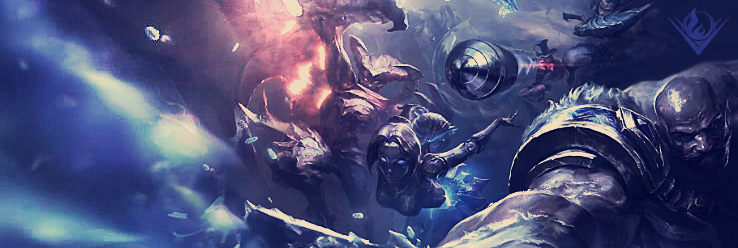Views: 2105 Generalities of mastery picking [S6]
|
Report
Having only 30 points to distribute on masteries can make picking them a pain. I made this article to cover some basics on what to consider when making a mastery page and some generalities of the different trees. For an overview of masteries check my previous article on the topic.
Most of what I say here assumes that masteries are somewhat balanced. If some masteries are too overpowered or too weak they'll be the exceptions for some tips. If that is the case I'll cover it in my in-depth articles on each tree as soon as I realize that a mastery is OP/UP.
2) Try to always get to a keystone mastery. Keystone masteries are just THAT powerful. They're always better than any of the other choices, and since you've got 3 options per tree, there's always one that works on a given champion.
3) Pick your masteries to enhance your play, play to enhance the effect of your masteries. When you pick masteries, you're enhancing different aspects of your champion. If you picked Feast
and
Feast
and
 Strength of the Ages
you may have to focus on farming (the jungle or minions), at least in laning phase. But when you start playing you have to lever the other team's playstyle. If you picked
Strength of the Ages
you may have to focus on farming (the jungle or minions), at least in laning phase. But when you start playing you have to lever the other team's playstyle. If you picked  Nasus top with those masteries and you're against
Nasus top with those masteries and you're against  Darius, you might have to farm only once every 20 seconds for
Darius, you might have to farm only once every 20 seconds for
 Feast
's regen and focus on killing siege minions for
Feast
's regen and focus on killing siege minions for
 Strength of the Ages
' stacks.
Strength of the Ages
' stacks.
3') Even if you're in a ranked game and you know exactly who you're facing against, sometimes things swing one way or the other. If you're as Irelia top against
Irelia top against  Riven, the way you play with your masteries will change depending on who won the early game or who killed the other first.
Riven, the way you play with your masteries will change depending on who won the early game or who killed the other first.
4) Higher tier masteries tend to be better than lower tier ones. In order to reward the commitment with one tree, they're balanced so that higher tiers mean higher rewards. The first 5-point masteries will always be the weakest and the most generic ones. This means often the best mastery pages will have 18 points in one tree and 12 in another. However, sometimes your champion has better synergy with a tier 1 batch than a tier 2 batch, so running 6 points in two trees may be good too.
5) Focus on some skills instead of trying to be "decent" at everything. We've all been there. You want your champion to have more hp regen, more mana regen, more AD for lasthitting and more AP because you're Xerath. But you can't. It's better to focus in what makes your champion good (more AP and magic penetration for
Xerath. But you can't. It's better to focus in what makes your champion good (more AP and magic penetration for  Xerath) or covering critical weaknesses (more mana for
Xerath) or covering critical weaknesses (more mana for  Anivia, early power for
Anivia, early power for  Vayne), instead of going all around and not solving any problem.
Vayne), instead of going all around and not solving any problem.
6) It's often better to pick 5 points on only one of the 5-point masteries per set. As said in (5), it's better to focus in what's better for your champion. Always go 5-points on one option if it's the only one that covers a critical weakness or late hyperscaling. You can go 3-2 if both masteries are useful, or 4-1 if you can do some math optimisation (if you have an idea of the proportion of magic/physical damage you might do, you can pick Battering Blows
and
Battering Blows
and
 Piercing Thoughts
accordingly*).
Piercing Thoughts
accordingly*).
*this doesn't work straight up linearly with the end of game statistics. For example, an AP assassin would need all 5 points on Piercing Thoughts
, since that 20% of physical damage was probably dealt with poke.
Piercing Thoughts
, since that 20% of physical damage was probably dealt with poke.
2) Check your enemies'/allies' keystone masteries and play around them. You can see what keystone mastery everyone picked by clicking on them and seeing the buff bar. This allows you to predict their gameplay pattern to some degree and help them (if they're your allies) or outplay them (if they're enemies). For example, if you see your enemy top laner picked Strength of the Ages
, you better harass a lot when the siege minion is about to die, so they have to choose between losing the trade or losing the stack.
Strength of the Ages
, you better harass a lot when the siege minion is about to die, so they have to choose between losing the trade or losing the stack.
Ferocity tree
As its name says it, this tree helps risky damage dealers and rewards them for dealing damage and killing things. Someone with 18 points in this tree will get rewarded for playing aggresive and constantly harassing their enemies. It's great for ad carries and assassins.
Cunning tree
The Cunning tree is the most utility based one, but it also has some damaging effects. Someone with 18 points in this tree will get rewarded for casting spells. It's great for most mages and mage/utility supports.
Resolve tree
The most defensive one. It boosts your survivability and gives some utility. Someone with 18 points in this tree will get rewarded for tanking damage and prolonging fights. It's great for tanks and tanky supports.
In-depth Cunning tree [S6]
In-depth Resolve tree [S6]
Most of what I say here assumes that masteries are somewhat balanced. If some masteries are too overpowered or too weak they'll be the exceptions for some tips. If that is the case I'll cover it in my in-depth articles on each tree as soon as I realize that a mastery is OP/UP.
General tips on mastery picking:
1) Assign your masteries in batches of 6 points. The way masteries are balanced means 1 point on one-point masteries is practically always better than 1 point on any of the 5-point choices. This is especially true for keystone masteries. By doing this, with 30 points you get to pick 5 batches, with each tree consisting of three batches.2) Try to always get to a keystone mastery. Keystone masteries are just THAT powerful. They're always better than any of the other choices, and since you've got 3 options per tree, there's always one that works on a given champion.
3) Pick your masteries to enhance your play, play to enhance the effect of your masteries. When you pick masteries, you're enhancing different aspects of your champion. If you picked
3') Even if you're in a ranked game and you know exactly who you're facing against, sometimes things swing one way or the other. If you're as
4) Higher tier masteries tend to be better than lower tier ones. In order to reward the commitment with one tree, they're balanced so that higher tiers mean higher rewards. The first 5-point masteries will always be the weakest and the most generic ones. This means often the best mastery pages will have 18 points in one tree and 12 in another. However, sometimes your champion has better synergy with a tier 1 batch than a tier 2 batch, so running 6 points in two trees may be good too.
5) Focus on some skills instead of trying to be "decent" at everything. We've all been there. You want your champion to have more hp regen, more mana regen, more AD for lasthitting and more AP because you're
6) It's often better to pick 5 points on only one of the 5-point masteries per set. As said in (5), it's better to focus in what's better for your champion. Always go 5-points on one option if it's the only one that covers a critical weakness or late hyperscaling. You can go 3-2 if both masteries are useful, or 4-1 if you can do some math optimisation (if you have an idea of the proportion of magic/physical damage you might do, you can pick
*this doesn't work straight up linearly with the end of game statistics. For example, an AP assassin would need all 5 points on
Tryhard tips for ranked:
1) Try to always make your mastery page after you picked your champion and/or know who you're going against. Start making it as soon as you lock-in your pick and tweak it once you know who you're going against. This way you can optimize your playstyle, getting a bit less counterpicked when counterpicked and being a harder counterpick when counterpicking.2) Check your enemies'/allies' keystone masteries and play around them. You can see what keystone mastery everyone picked by clicking on them and seeing the buff bar. This allows you to predict their gameplay pattern to some degree and help them (if they're your allies) or outplay them (if they're enemies). For example, if you see your enemy top laner picked
What is every tree good for?
The whole point of changing the names of the trees from Offense/Defense/Utility to Ferocity/Resolve/Cunning was to highlight what playstyle each tree supports. If you're going to play aggresively you might want to go 18 points on Ferocity and 12 in Resolve/Cunning. As most trees have something that can be used by most champions, mastery pages should be more champion-specific than before, and even playstyle-specific.Ferocity tree
As its name says it, this tree helps risky damage dealers and rewards them for dealing damage and killing things. Someone with 18 points in this tree will get rewarded for playing aggresive and constantly harassing their enemies. It's great for ad carries and assassins.
Cunning tree
The Cunning tree is the most utility based one, but it also has some damaging effects. Someone with 18 points in this tree will get rewarded for casting spells. It's great for most mages and mage/utility supports.
Resolve tree
The most defensive one. It boosts your survivability and gives some utility. Someone with 18 points in this tree will get rewarded for tanking damage and prolonging fights. It's great for tanks and tanky supports.
Next articles on masteries:
In-depth Ferocity tree [S6]In-depth Cunning tree [S6]
In-depth Resolve tree [S6]

















New Comment
You need to log in before commenting.